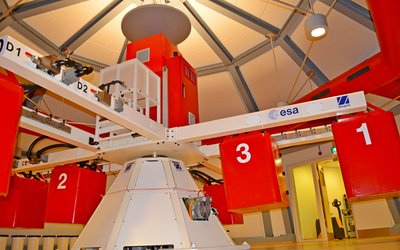Meet the teams: PolVol
Four teams of university students were selected to develop and perform their hypergravity experiments during ESA's 'Spin your Thesis!' 2011 campaign. Here is an introduction to the Canadian and French team.
![]()
![]()
Effect of hypergravity on intracellular trafficking in growing pollen tubes
![]()
![]()
| University | Université de Montréal |
| Endorsing professor |
Anja Geitmann IRBV, Département de sciences biologiques |
| ELGRA mentor |
Jack J.W.A. van Loon Dutch Experiment Support Center |
| Team | Youssef Chebli, Maxime Grare |

The PolVol team was composed of two students, one studying at the Université de Montréal (Canada) and another on exchange from the Université de Rouen (France). The team investigated how plant cells adapt their metabolism to changes in gravity. More specifically, they determined how the intracellular dynamics of pollen tubes are affected by hypergravity.
Throughout their evolution, land plants have adapted to the constant mechanical load imposed by gravity acting on their cellular structure. Some plants are equipped with statoliths, heavy organelles or granules that sink to the bottom of the cell, allowing the plant to perceive gravity. However, even plants without statoliths are known to react to changes in gravity level.
Plants have developed two methods to cope with the mechanical loads imposed by gravity: balancing the internal pressure and the tensile resistance in the primary cell wall; and producing stiff secondary walls. Changes in gravitational strength have been shown to disrupt the growth of cell walls. The mechanism for this disruption – in plant cells not equipped with statoliths – was the topic of investigation in this experiment.

In PolVol’s experiment, the students investigated two separate but related phenomena on pollen tubes exposed to hypergravity: the spatial distribution profiles of the different cell wall components, and the modulation of chemical transport within the tubes through a process known as vesicle trafficking. Pollen tubes were selected for their rapid growth rates, allowing the experiment to be performed on the timescale of hours, whereas a much longer period would be required for other types of plant cells.
The spatial distribution profiles of the different cell wall components were investigated on chemically fixed samples at the students’ universities, following exposure to hypergravity at the Large Diameter Centrifuge (LDC) at ESTEC, in Noordwijk, the Netherlands.
Data on the modulation of vesicle trafficking was gathered in the form of time lapse images. A video camera attached to a fluorescent microscope inside an LDC gondola was used to obtain images of the growing pollen tubes whilst they were subjected to hypergravity. A dye injected into the growth medium was used to detect the vesicle trafficking. Image analysis of the acquired video footage provided quantitative insights into the phenomena being studied.
Read the scientific article published by the PolVol team in the Plos One journal.
Read the final experiment report here.






